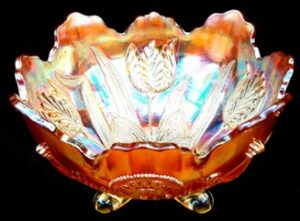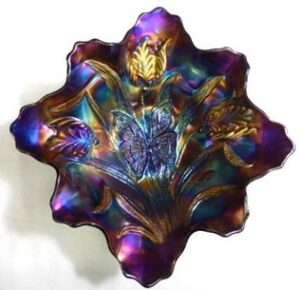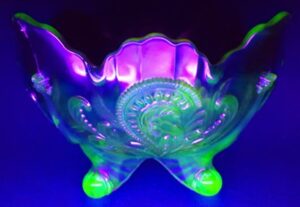Butterfly and Tulip
By Dr. Larry Keig
Dugan’s Butterfly and Tulip’s interior pattern is a striking lifelike design. Its essential elements are a single butterfly, three tulips, and finely textured leafage found in nature with this variety of flower. Its exterior, Inverted Fan and Feather, is anything but representational. It is, instead, a curious, difficult-to-describe abstract design.
The abundant butterfly, centrally placed, appears to be a type of swallowtail. The swallowtail butterfly is characterized by elongated hind wings which resemble a bird with the same name. They’re around from mid-April through early October in the U.S. central states. (1) The butterfly on carnival bowls is, as Christina Katsikas (Carnival Glass Showcase) has noted, “outlined with flattened lines, like the Soda Gold pattern” off which iridescence can reflect.
The tulips, situated above and to the left and right of the butterfly, look like a variety of late-blooming parrot tulips which reveal themselves from mid April through late May in the Upper Midwest. The tulip above the butterfly is fully open. Those which flank the insect are not yet quite as exposed.
Shapes
Butterfly and Tulip bowls are available in at least six shapes, one the cream of the crop. All rest on four sturdy ball feet. Their outer edges are serrated. By far the most desirable shape and arguably the most attractive is the flared square ruffled. Its eight ruffles are placed in such a way that the bowl appears quadratic. It should not be confused with a typically ruffled round or a shape that is more rightfully called “quasi square” (see below).
The illustrated square-ruffled is the Betkers. Dick has suggested (Carnival Glass Showcase) that “it looks like it could be green. It reminds me of a butterfly in a lush green garden.” It measures ten and one-half inches from top to bottom and from side to side. It measures 12 inches diagonally in both directions.
The “quasi-square” is a deep round in which the eight ruffles are alternately turned up and turned down. To some, these bowls appear square but are actually spherical in shape. They range from ten to ten and one-half inches in diameter and stand about five and one-half inches tall. Pictured is one that sold at a Seek auction in April 2018.
All ruffles of a bona fide deep round look alike. In this case, they are turned up and out. The marigold on Vaseline pictured above and described below is configured this way.
The broadly-ruffled deep round, above, is the typical Dugan eight-ruffled. It is similar in shape to the eight-ruffled Cherries/Jeweled Heart, Smooth Rays/J.H., and other large eight-ruffled bowls with this exterior pattern and other back patterns. The illustrated broadly ruffled sold at a Wroda auction in February 2014.
The diamond shape, above, is a whimsied broadly eight-ruffled with sides pulled outward and the tulip at the top and the antennae of the butterfly tucked under the uppermost ruffle. Pictured is the alluring amethyst that sold at the Engel/ACGA auction in June 2017.
The so-called banana-shape, above, longer in one direction than the other, has been configured in two different ways. One version has two opposite sides folded in. The other is conventionally oblong with two opposite sides bulging and the other two tapered. Pictured is a marigold with two sides up that sold in a Seeck auction in February 2012.
A deep non-ruffled round would in all likelihood be the proof shape. It has yet to be reported.
Colors
For decades, Butterfly and Tulip bowls had been widely reported only in marigold and purple/amethyst. Now it is known that other base and surface colors exist.
Marigold and Purple/Amethyst. While marigold and amethyst may be about equally available, the amethyst is more highly sought. Multiple factors may explain the difference in desirability. One is the greater availability of the particularly attractive flared square ruffled shape in amethyst. Another is the likelihood the iridescence of the amethyst is of superior quality, sometimes a knockout.
Speaking of knockouts, the above illustrated electric blue and purple-on-purple square-ruffled meets this criterion. Especially large in dimensions, it measures ten and three-fourth inches across and thirteen inches on the diagonal.
As Jim Wroda who once owned it recalled, he had known of it “since 1989. BY FAR the best one I have ever seen. The iridescence is like hand painted art. It came from a house in Marietta, Ohio, where it resided for more than 30 years before I was able to get it. Once Stacy [Wills] saw it, he grabbed it.” After that, it was owned by Gary Heavin until he sold it in 2014 to Christina Katsikas.
The marigold are seen less frequently in the flared square ruffled than any B&T shape other than the diamond. Even then, they tend to be pulled up more than the amethyst in this shape. The illustrated marigold square ruffled is a pretty one that sold in a Wroda auction in May 2013.
Peach Opal. A single peach opal Butterfly and Tulip bowl is an acclaimed rarity. It is in the flared square ruffled shape. It measures about 11 inches from top to bottom and from side to side and substantially more than that diagonally in both directions. Its surface color is a vibrant orange. Its opalescence covers nearly all of the exterior. The photo here is from the HOC site.
Its storied provenance can be traced back at least 20 years. In 2000, John Rogers bought it at the Hill collection auction conducted by Tom Burns. Six years later, Jackie Poucher purchased it at one of John’s auctions. She later passed it on to Gary Heavin who later sold it privately to Karen Engel for an astonishingly large sum. Heavin bought it back for significantly less than that when it sold again in 2017 at the Engel/Wroda/ACGA convention auction. Unless he has disposed of it since, it remains in his collection.
Marigold on Vaseline. The inspiration for this article came after a vaseline Butterfly and Tulip has been confirmed. (2) Its owners, Kate and Bill Lavelle, bought it as marigold but subsequently discovered that it glowed under a black light. Kate describes the color of the feet as “honey yellow,” (see photo top and bottom, which also shows the peculiar Inverted Fan and Feather exterior), not “the intense yellow or strong greenish base glass one would expect with vaseline.” Thus, they weren’t exactly sure what they had until its color had been authenticated. The bowl is a ruffled round with all ruffles turned up and out in the same way. It measures nine and one- eighth inches in diameter from tallest point to tallest point, eight and three-fourth inches from shortest point to shortest point, and stands five and five-eighth inches tall. Its surface color is a dark marigold. It is, without question, a conversation piece.
Now where’s the Vaseline B&T without the overlay?
Notes:
(1) I have little knowledge of the world of flora and fauna. But Kate Lavelle does so readers and I have the benefit of her study and interest in lepidoptera and blooming plants.
(2) At a major club convention a few years back, two long-time collectors with undisputed expertise verified its base color as marigold on Vaseline and not, as the Lavelles were inclined to believe at the time, a flukish marigold on clear.
Photos courtesy of Kate LaVelle, Dick Betker, Christina Katsikas, Seeck Auctions, and Matthew Wroda Auctions.
This article first appeared in the ICGA Pump in the June 2020 issue and is reprinted with permission.












